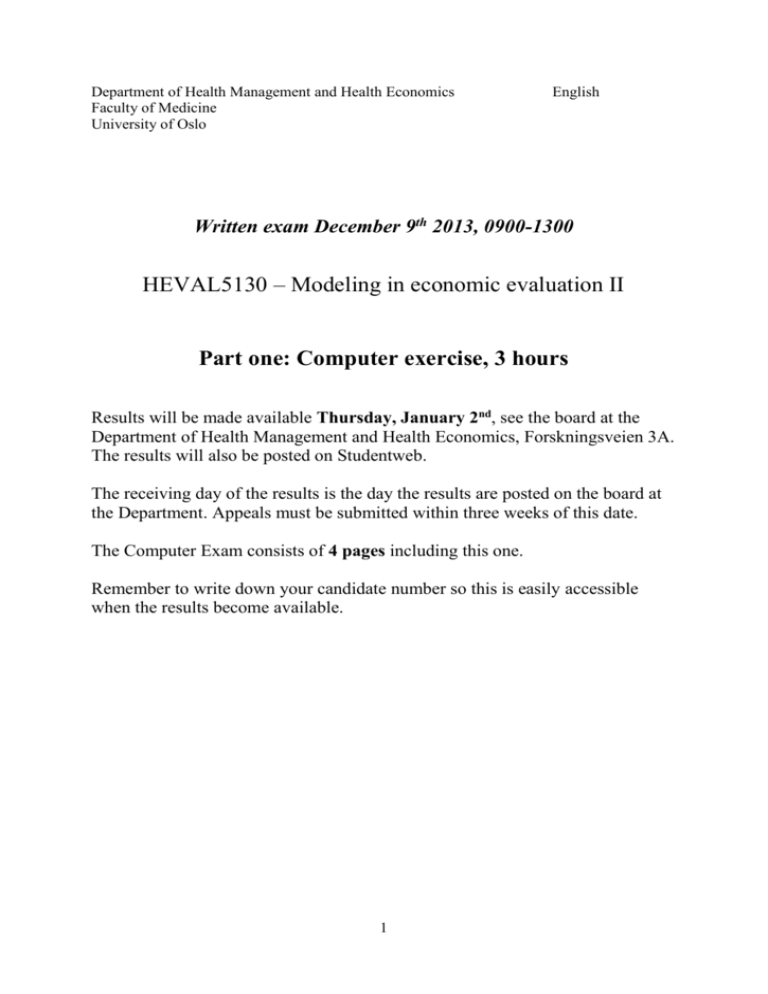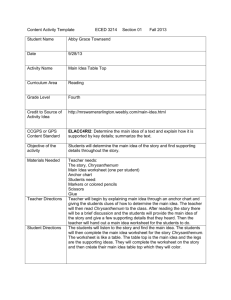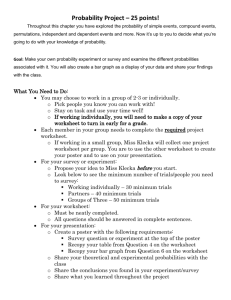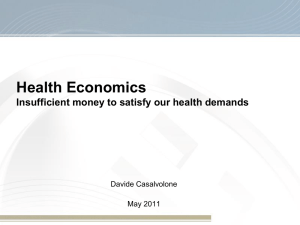Exam fall 2013, part 1
advertisement

Department of Health Management and Health Economics Faculty of Medicine University of Oslo English Written exam December 9th 2013, 0900-1300 HEVAL5130 – Modeling in economic evaluation II Part one: Computer exercise, 3 hours Results will be made available Thursday, January 2nd, see the board at the Department of Health Management and Health Economics, Forskningsveien 3A. The results will also be posted on Studentweb. The receiving day of the results is the day the results are posted on the board at the Department. Appeals must be submitted within three weeks of this date. The Computer Exam consists of 4 pages including this one. Remember to write down your candidate number so this is easily accessible when the results become available. 1 FINAL EXAM HEVAL 5130 – December 9, 2013 – 3 hours computer exercise Below you will find information about the computer exercises. The necessary files are uploaded onto the desktop of your computers. Please, save your Excel and Treeage files to the memory stick provided when you have finished your assignment. Name your files with candidate number, but NOT your own name. The memory sticks will be collected when the computer session is finished. You have at maximum 3 hours for the computer exercises. When you have finished your computer exercises, you shall move away from the computers and answer theory questions. Exercise 1 (Treeage computer exercise) A. Add distributions to the TreeAge model provided (see table below or in Excel-file provided) B. Perform a Monte Carlo simulation and produce a scatter plot and a CEAC C. Produce a graph that shows the EVPPI vs. WTP for the following groups of parameters; probabilities, costs, utilities and efficacy. D. Non-mandatory bonus exercise: Produce the TreeAge model in Excel Values for model Costs Name Description cAmput cBlind Cost per year of being amputated (leg) Cost per year for being blind Cost per year of treatment for coronary heart cCHD disease Yearly cost of control Cost per year of treatment for cerebrovascular cCVD disease cDiab Cost per year of diabetes treatment Yearly cost of intervention Probabilities Estimated Low cost 18252 7520 61668 13321 9544 7000 Description pAmi pAmput pBlind pStroke QALYs Probability of having AMI Probability of amputation Probability of becoming blind Probability of having a stroke Name Description qAmput qBlind qCHD qCVD qDiab Effect Yearly QALY when having amputated leg Yearly QALY when being blind Yearly QALY with CHD Yearly qaly with cerebrovascular disease Yearly QALY for diabetic Name Description 12537 Not uncertain 87532 4788 18000 2911 6665 Not uncertain Estimated QALY 0,6 0,58 0,69 0,67 0,75 Estimated hazard ratio 2 28984 110015 165277 Estimated probability 0,02 0,003 0,004 0,01 Name 6551 High 243022 Total (N) 5678 789 1234 3456 Events per year 114 2 5 35 Low High 0,40 0,38 0,49 0,47 0,67 0,80 0,78 0,89 0,87 0,83 Low High rrIntAmi rrIntAmput rrIntBlind rrIntDie rrIntStr Effect of intervention on AMI Effect of intervention on risk of amputation Effect of intervention on going blind Effect of intervention on mortality Effect of intervention on stroke 0,75 0,95 0,85 0,9 0,8 0,65 0,75 0,65 0,66 0,66 0,86 1,20 1,12 1,23 0,97 Exercise 2: Excel computer exercise - Cervical cancer diagnosis and treatment A hypothetical group of women has underlying stage I cervical cancer. Each year their cancer has a probability of being detected and cured. However, if their cancer was not detected, there is a small stage-specific probability that the cancer will progress from Stage I to II, from stage II to III and from III to IV. In addition, each year, the women with Stage IV cancer face a probability of dying. Finally, there is a small probability of relapse back to Stage I after a successful cure. A trial was conducted resulting in the following transition table: Transition table: Stage 1 Stage 2 Stage 3 Stage 4 Stage 1 0 129 0 0 Stage 2 0 0 300 0 Stage 3 0 0 0 400 Stage 4 0 0 0 120 Cure 90 0 0 0 Total Cured 631 900 600 240 300 Dead 0 0 0 240 0 760 1200 1000 600 390 The following are the annual costs and utilities associated with each health state: Stage I Stage II Stage III Stage IV Cured $1,000 Cost, mean $20,000 $25,500 $31,000 $35,000 $1,000 Cost, se $10,000 $12,000 $15,000 $17,000 .98 Utility, mean 0.91 0.85 0.80 0.60 .05 Utility, se .05 .05 .07 .04 There is a new drug (DrugX) that can be taken after the cancer has been cured. DrugX reduces the transition probability from the Cured state back to Stage I by a relative risk (RR) of 0.51. Assume a lognormal distribution (the ln(mean) and ln(se) have already been inserted for you in the excel document (cells F40 and G40, respectively)). The cost of DrugX is $2,350 per year (with no uncertainty). An Excel document has been provided for you to perform a probabilistic sensitivity analysis (PSA) in order to compare 1) the current standard of treatment (no drug) to 2) using DrugX. Please become familiar with the different worksheets and notice that the equations to calculate the Markov trace have been completed for you in the “Model” worksheet. Use a Beta or Dirichlet distribution for the transition probabilities (where appropriate), Gamma distribution for costs, Beta distribution for utilities and Lognormal for the relative risk. 1. Complete the model in Excel in order to be able to conduct a PSA. All blue/shaded cells in the “Parameter” worksheet require user input (you need to fill in yourself) while all cells that are white have been filled in for you and should NOT be changed. Cells E9:E19 are highlighted in light green. For these cells you must decide if (and which) cells require your input. a. Use the logic function (=IF) to allow the model to switch back and forth between deterministic (0) and probabilistic (1) (i.e., fill in the appropriate cells in column B on the “Parameter” worksheet with a function that allows the user 3 to toggle between using column C and column D by changing cell C3 between 1 and 0). b. Fill in the alpha and beta values for the transition probabilities (cells F9:G19) using the values from the transition table (located to the right on the “Parameter” worksheet). c. Fill in the mean and standard error (SE) for the costs and utilities using the table provided above. d. Calculate the deterministic value (column D) and fill in the correct equation to pull a random draw from the appropriate distributions in the probabilistic column (column C). 2. Which transition probability(ies) required a Dirichlet distribution? Briefly explain why. Please fill in your answer in the text box provided for you on the “Answers” worksheet. 3. What are the alpha and beta parameters for the transition probability from Stage III cancer to Stage IV cancer? Please fill in your answer in the text box provided for you on the “Answers” worksheet. 4. Run the PSA macro provided for you on the “PSA_results” worksheet. This macro will run 2,000 simulations. If you cannot complete the steps from question 1, you may still receive partial credit for answering question 4 by using the provided simulation output on the worksheet entitled, “USE ONLY IF NEEDED.” Using the 2,000 simulations, calculate the probability DrugX is cost-effective for: a. A willingness to pay threshold of $20,000 per QALY gained. b. A willingness to pay threshold of $100,000 per QALY gained. (Hint: If you calculate net monetary benefit, the function =COUNTIF(range; ”>0”) may come in useful. The range should be referenced appropriately).Please show your work in the appropriate worksheet and report your final answers in the text box provided for you on the “Answers” worksheet. When you have finished your computer exercises, you shall move away from the computers and answer theory question. You have at maximum 3 hours for the computer exercises. 4






